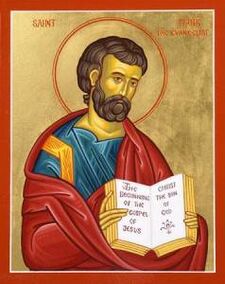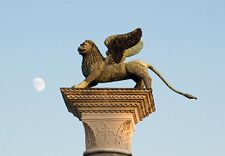Saint Mark the Evangelist: Difference between revisions
Created page with "Saint Mark is the patron saint of attorneys, barristers, Venice, Italy, and Egypt. 225px|right|thumb|St. Mark the Evangelist == History of the Saint == ..." |
|||
| Line 8: | Line 8: | ||
== Venice == | == Venice == | ||
Mark was buried in Alexandria, until 828 when two Venetian merchants stole relics | Mark was buried in Alexandria, until 828 when two Venetian merchants stole relics that were believed to have been Mark’s remains and took them to Venice. A basilica was built to house the relics. | ||
There is a mosaic on Saint Mark’s Basilica showing how the sailors covered the relics with a layer of pork. Since Muslims are not allowed to touch pork, this action was done to prevent Muslim intervention in the relic’s removal. | There is a mosaic on Saint Mark’s Basilica showing how the sailors covered the relics with a layer of pork. Since Muslims are not allowed to touch pork, this action was done to prevent Muslim intervention in the relic’s removal. | ||
However, Copts, followers of the Coptic Orthodox Church, believe that the head of the saint remained in Alexandria. Every year, on the 30th day of the month of Paopi, the second month of the Coptic calendar (between October 11th and November 9th), the Coptic Orthodox Church celebrates the commemoration of the consecration of the church of St. Mark, and the appearance of the head of the saint in the city of Alexandria. This takes place inside St. Mark Coptic Orthodox Cathedral in Alexandria, where the saint's head is preserved. | However, Copts, followers of the Coptic Orthodox Church, believe that the head of the saint remained in Alexandria. Every year, on the 30th day of the month of Paopi, the second month of the Coptic calendar (between October 11th and November 9th), the Coptic Orthodox Church celebrates the commemoration of the consecration of the church of St. Mark, and the appearance of the head of the saint in the city of Alexandria. This takes place inside St. Mark Coptic Orthodox Cathedral in Alexandria, where the saint's head is preserved. | ||
In the Eastern Orthodox Church, the Feast Day of Mark the Evangelist is April 25th. | In the Eastern Orthodox Church, the Feast Day of Mark the Evangelist is April 25th. | ||
==Legend== | ==Legend== | ||
Revision as of 20:31, 12 December 2012
Saint Mark is the patron saint of attorneys, barristers, Venice, Italy, and Egypt.

History of the Saint
Saint Mark or Mark the Evangelist was one of the Seventy Apostles of Christ, a group of men who were sent out by Jesus to spread his teachings throughout Judea. However, when Jesus asked for his disciples to eat his body and drink his blood many of the seventy apostles left him, including Mark. After Jesus’s crucifixion Peter was arrested and once released he escaped to Rome where he reunited with Mark. Peter then restored Mark’s faith and had him stay with him as his interpreter. During this time, he recorded Peter’s sermons and composed the Gospel According to Mark; he then left for Alexandria. Once in Alexandria, he founded of the Church of Africa, and became the first Bishop of Alexandria.
Mark was martyred during the reign of Emperor Nero; however there are contradictions as to when exactly, most Biblical chronologists place his death between the 8th year to 14th year of Nero’s reign (A.D. 63-A.D. 68). This would place his death to either right before or right after Nero began persecuting Christians. It is believed right before because the Roman guards dragged him through the streets of Alexandria but did not kill on the first day, they wait until the second day; where they once again tied a rope to his neck and dragged him through the streets of Alexandria, until he was dead.
Venice
Mark was buried in Alexandria, until 828 when two Venetian merchants stole relics that were believed to have been Mark’s remains and took them to Venice. A basilica was built to house the relics. There is a mosaic on Saint Mark’s Basilica showing how the sailors covered the relics with a layer of pork. Since Muslims are not allowed to touch pork, this action was done to prevent Muslim intervention in the relic’s removal.
However, Copts, followers of the Coptic Orthodox Church, believe that the head of the saint remained in Alexandria. Every year, on the 30th day of the month of Paopi, the second month of the Coptic calendar (between October 11th and November 9th), the Coptic Orthodox Church celebrates the commemoration of the consecration of the church of St. Mark, and the appearance of the head of the saint in the city of Alexandria. This takes place inside St. Mark Coptic Orthodox Cathedral in Alexandria, where the saint's head is preserved.
In the Eastern Orthodox Church, the Feast Day of Mark the Evangelist is April 25th.
Legend
There are many legends surrounding the relics of Saint Marck. The first has to do with the transport of his remains. The two Venetians merchants were able to keep the relics hidden from the Muslims, but when they reached the ocean a great storm arose before them. Saint Mark then appeared to the captain and warned him to strike all his sails immediately, lest the ship, driven before the wind, should be wrecked upon hidden rocks. They owned their safety to this miracle. The second dates back to 1063, during the construction of a Saint Mark’s Basilica, when Saint Mark's relics could not be found. According to tradition, in 1094 the saint himself revealed the location of his remains by extending an arm from a pillar. The newfound remains were placed in a sarcophagus in the basilica.
Lion as the Symbol of Saint Mark

The winged lion is the symbol of St. Mark the Evangelist, and is used as the logo for St. Mark's Parish. This symbol comes from St. Mark's description of John the Baptist's voice "crying out in the wilderness" upon hearing the Word of God (Mark 1:3). His voice is said to have sounded like that of a roaring lion. This lion symbolism also appears in a vision of the Prophet Ezekiel where four winged creatures represent the four evangelists (Ezekiel 1:10). Matthew is depicted as a human, Mark as a lion, Luke as a bull, and John as an eagle.
See also
References
NULL